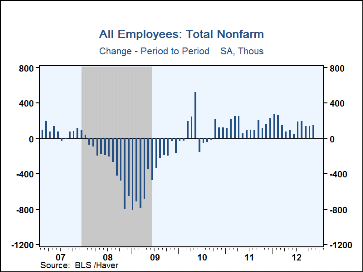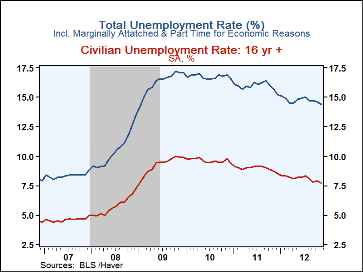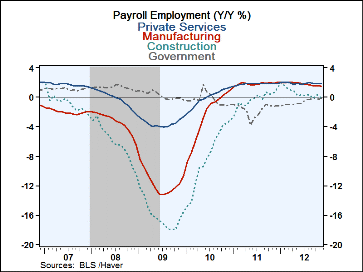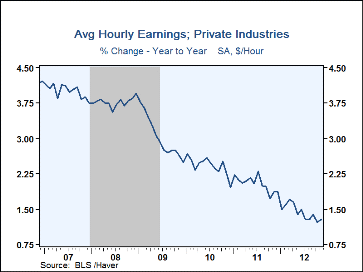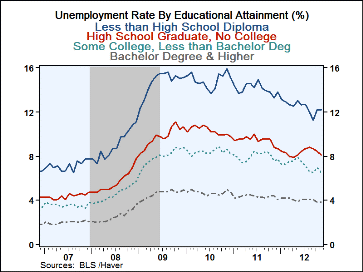 Global| Dec 07 2012
Global| Dec 07 2012U.S. Job Market Continues To Improve Despite Hurricane Sandy
by:Tom Moeller
|in:Economy in Brief
Summary
Nonfarm payrolls grew 146,000 during November following gains of 138,000 and 132,000 during the prior two months, revised down from 171,000 and 148,000, respectively. A 110,000 increase was expected. As measured in the household [...]
Nonfarm payrolls grew 146,000 during November following gains of 138,000 and 132,000 during the prior two months, revised down from 171,000 and 148,000, respectively. A 110,000 increase was expected. As measured in the household survey, the unemployment rate slipped to 7.7%. An unchanged 7.9% was expected. Including those marginally employed as well as those working part time for economic reasons, the jobless rate slipped to 14.4%. Total employment fell 122,000 (+1.9% y/y) but the labor force shrank by 350,000 (+0.9% y/y).
Total nonfarm payrolls grew 146,000 last month despite Hurricane Sandy, a slight improvement from the two earlier months where growth was revised lower. Since October, a relatively stable 59.0% of industries added jobs but over three months an improved 63.5% added workers. Last month's improvement occurred as state government employment grew (0.5% y/y) after a sharp October decline and fewer local government jobs were lost (-0.2% y/y) after two months of notable drop.
The storm seemed to have its largest impact on construction sector jobs, which fell 20,000 (-0.1% y/y). Factory sector jobs also fell by 7,000 (+1.5% y/y). More than offsetting these declines was a solid 169,000 (1.9% y/y) rise in private service sector employment, nearly its strongest since February. Retail sector employment rose 52,600 (1.2% y/y). Professional & business services jobs grew by 43,000 (3.0% y/y), helped by an 18,000 (7.7% y/y) rise in temporary employment. Leisure & hospitality employment rose 23,000 (2.3% y/y) and jobs in education & health gained 18,000 (2.0% y/y).
The length of the average workweek was stable m/m at 34.4 hours, though that was reduced from its peak of 34.6 nine months ago. As a result, aggregate hours worked (employment times hours) rose 0.2% last month. For 4Q so far they are up 1.3% (AR) from Q3 after that quarter's 1.0% rise.
Average hourly earnings rose 0.2% (1.3% y/y) following a 0.1% October increase. The improvement owed to a 0.3% (4.7% y/y) increase in mining & logging and a 0.2% (1.2% y/y) gain in manufacturing. Private service-producing earnings rose 0.1% (1.2% y/y). A 0.7% (4.5% y/y) rise in financial activities was offset by a 0.1% (1.3% y/y) decline in leisure & hospitality.
The unemployment rate fell to 7.7% while the overall unemployment rate slipped to a still relatively high 14.4%. Nearly 30% of those unemployed had been jobless for 52 weeks or longer. The labor force decline of 350,000 (+0.9% y/y) owed to an increase of 542,000 workers (2.8% y/y) who chose not to be in the labor force. Just 63.6% of the population were in the labor force versus 66.8% at its peak from 1998 through 2000. Employment fell 122,000 last month following two months of sharp increase.
The unemployment rate for those 25 years and over was 6.5% but 23.5% for teens. By educational attainment, the jobless rate for those with less than a high school diploma was 12.2%. For high school graduates but no college it was 8.1% and 6.5% for those with some college. For college graduates the unemployment rate was 3.8%.
The figures referenced above are available in Haver's USECON database. Additional detail can be found in the LABOR and in the EMPL databases. The expectation figures are from Action Economics and are in the AS1REPNA database.
| Employment: (M/M Chg., 000s) | Nov | Oct | Sep | Y/Y | 2011 | 2010 | 2009 |
|---|---|---|---|---|---|---|---|
| Payroll Employment | 146 | 138 | 132 | 1.4% | 1.2% | -0.7% | -4.4% |
| Previous | -- | 171 | 148 | -- | -- | -- | -- |
| Manufacturing | -7 | 10 | -16 | 1.5 | 1.8 | -2.7 | -11.6 |
| Construction | -20 | 15 | -1 | -0.1 | -0.3 | -8.2 | -16.0 |
| Private Service Producing | 169 | 171 | 139 | 1.9 | 1.8 | -0.1 | -3.5 |
| Government | -1 | -51 | 10 | -0.2 | -1.7 | -0.3 | 0.2 |
| Average Weekly Hours - Private Sector | 34.4 | 34.4 | 34.5 | 34.4 (Nov'11) |
34.4 | 34.1 | 33.9 |
| Average Private Sector Hourly Earnings (%) | 0.2 | 0.1 | 0.3 | 1.3 | 2.0 | 2.4 | 3.0 |
| Unemployment Rate (%) | 7.7 | 7.9 | 7.8 | 8.7 (Nov'11) |
9.0 | 9.6 | 9.3 |
Tom Moeller
AuthorMore in Author Profile »Prior to joining Haver Analytics in 2000, Mr. Moeller worked as the Economist at Chancellor Capital Management from 1985 to 1999. There, he developed comprehensive economic forecasts and interpreted economic data for equity and fixed income portfolio managers. Also at Chancellor, Mr. Moeller worked as an equity analyst and was responsible for researching and rating companies in the economically sensitive automobile and housing industries for investment in Chancellor’s equity portfolio. Prior to joining Chancellor, Mr. Moeller was an Economist at Citibank from 1979 to 1984. He also analyzed pricing behavior in the metals industry for the Council on Wage and Price Stability in Washington, D.C. In 1999, Mr. Moeller received the award for most accurate forecast from the Forecasters' Club of New York. From 1990 to 1992 he was President of the New York Association for Business Economists. Mr. Moeller earned an M.B.A. in Finance from Fordham University, where he graduated in 1987. He holds a Bachelor of Arts in Economics from George Washington University.


